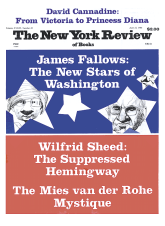In response to:
The Edo Lear from the April 24, 1986 issue
To the Editors:
As Jan Kott says in his comparison of Ran with a subset of other Lears [NYR, April 24], “everyone, adapters as well as stage producers, have had to grapple with the historical setting of King Lear,” and goes on to credit Kurosawa with the discovery of a “new historical place for Shakespeare’s royal dramas.” This, he tells us, is “the Edo period, before the consolidation of the almost absolute power of the shogun in Kyoto.” Unfortunately, both the period and its capital are misidentified. To set the record straight, there was a consolidation of political power in the early seventeenth century following which the de facto capital of Japan became Edo (not Kyoto). Edo has remained the capital ever since, although the name was changed to Tokyo after the shogunate government collapsed. The period in between, some two hundred thirty years, is commonly called the Edo period. This is not the period Kott is referring to; he must mean the preceding fifty or a hundred years.
Kurosawa must also have had the same pre-Edo years in mind, since the large scale use of muskets and cavalry in warfare didn’t occur in earlier times. If the chronological space in which the action takes place can be pinpointed, however, the same cannot be said about the cultural space. While he speaks of historicism versus anachronism, I think that Kott and probably most other western viewers don’t appreciate the degree to which Ran isn’t just a free adaptation, a reinvention of Shakespeare, but is a reinvention of medieval Japan at the same time. I wonder if this isn’t why the film appears so differently to its different audiences: a brilliant adaptation with subtitles by Shakespeare to literate western audiences, a science fiction journey to a land that never was to those who listen instead of read.
James M. Diamond
Berkeley, California
This Issue
June 12, 1986



